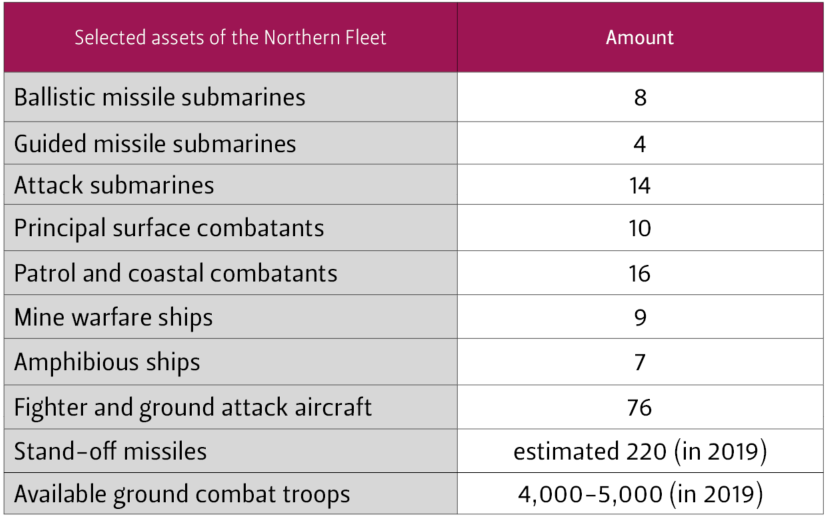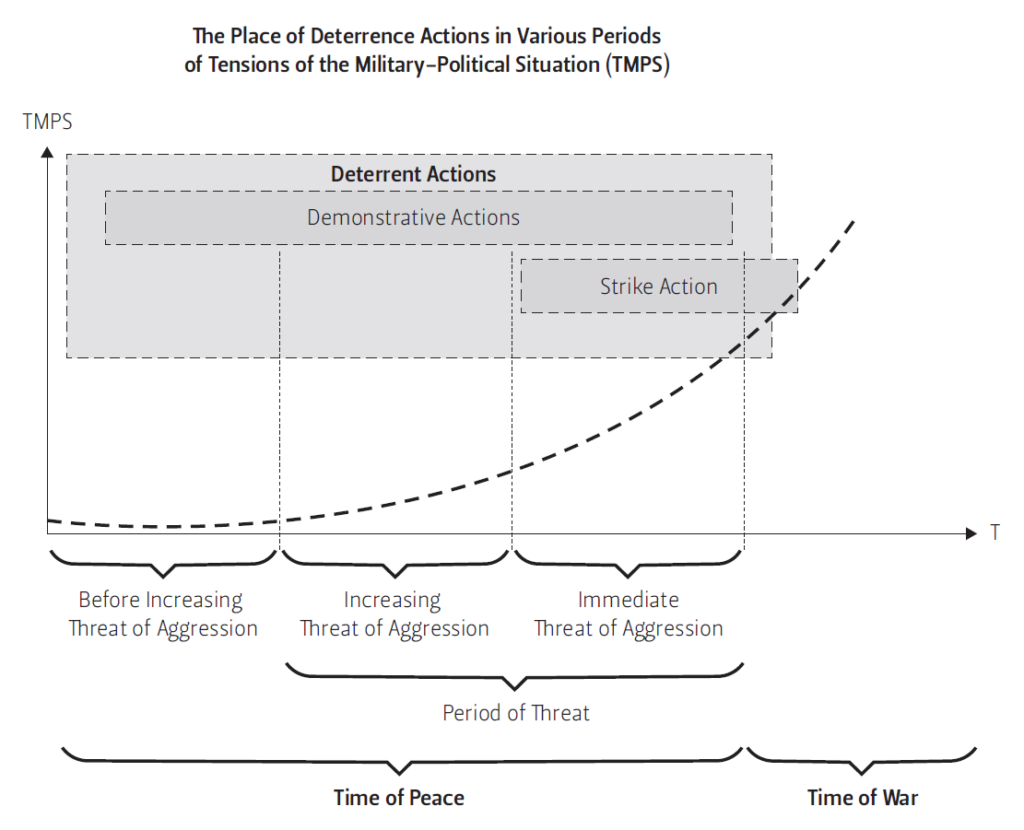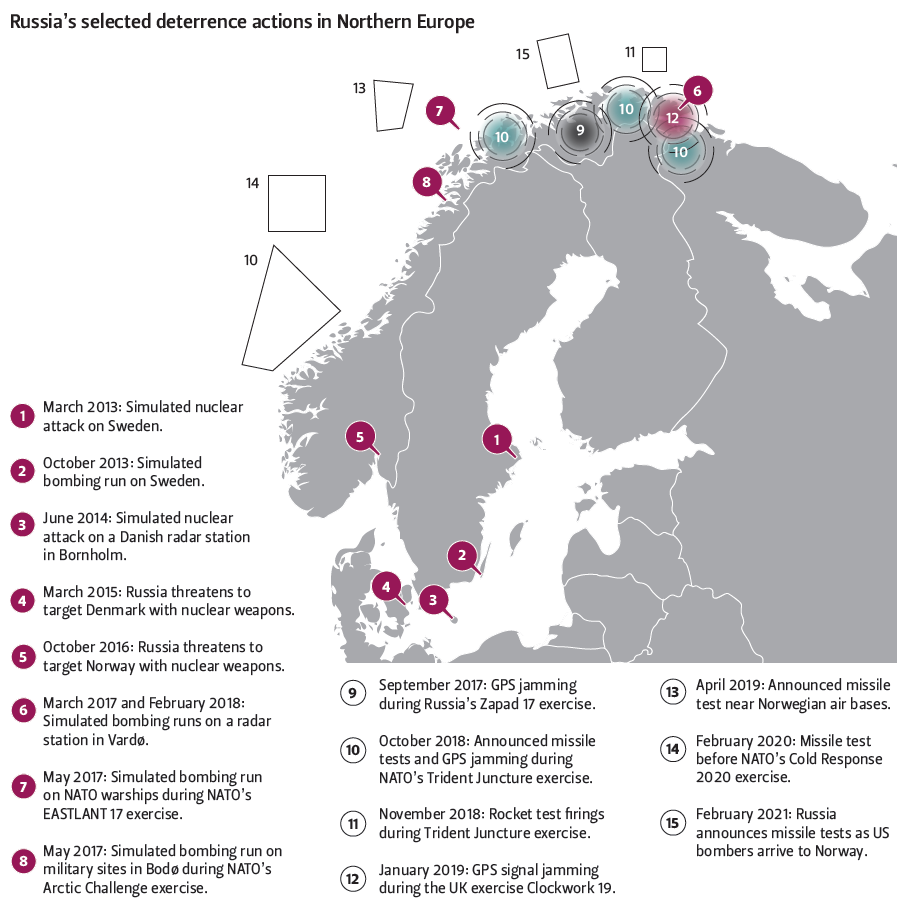Sammanfattning
- Formerly comprising the nuclear relationship between Russia and the US, Russia’s redefined concept of strategic stability includes all forms of military activity, and integrates local, regional, and global questions into a single framework.
- Russia views Northern Europe primarily through its overall relationship with NATO and the US. This also has implications for the Nordic states when Russia views their actions in building territorial defence through its own perception of stability.
- Russia sees security environments as systems whose ‘balance’ it needs to sustain with various methods. ‘Defensive’ methods include military build-up; ‘offensive’ methods coercion and intimidation. In Northern Europe, these actions have been directed particularly towards Norway since 2016.
- There are signs of a remilitarisation of the Norwegian Sea and the High North, where some aspects of Russia’s military activities have exceeded Cold War levels.
- Nordic countries should be aware that Russia’s concept of regional stability is different from theirs. Despite reassurance, Russia may deem international cooperation between others or even their efforts to maintain national defence as destabilising.
Introduction: strategic stability redefined
The concept of strategic stability has traditionally been associated with a stable nuclear relationship between leading nuclear powers, the US and USSR/Russia. Their last commonly agreed definition of the concept in 1990 formed the basis of the START negotiations, defining strategic stability as a nuclear relationship, where neither side has an incentive to attempt a disarming strike. In 2016, Russia and China suggested replacing the concept of strategic stability with ‘global strategic stability’ by arguing that the conventional definition of strategic stability as a military category concerning only nuclear weapons was outdated.[1] Instead, they seek to redefine strategic stability as a concept concerning the state of great-power relations, with both political and military categories, the military category being the focus of analysis in this paper. Russia and China underline their claim by making no other mention of nuclear weapons in the entire document, which proposes the following definition of strategic stability in the military field:
“All States should maintain their military capabilities at the minimum level required to ensure their national security; should deliberately refrain from taking any such actions as […] building up their militaries and […] expanding military political alliances that may be seen by other members of the international community as a threat to their national security, forcing them to take countermeasures to restore the undermined balance […].”
Russia and China reaffirmed these principles in another joint statement in 2019 concerning arms control, indicating that nuclear deterrence remains a centrepiece of Russia’s concept of strategic stability, but that the new definition is also upheld. This shift is also reflected in the ideas of Russian experts close to the Russian Foreign Ministry, who seek to redefine strategic stability as a state of relations between great powers, where military clashes between them cannot occur.[2]
As the 2016 statement explicitly notes, non-nuclear capabilities and the conventional military balance also have strategic significance for Russia. Moreover, the document indicates that issues affecting global stability include regional and even local military-political problems. Naturally, this also includes Northern Europe. The significance of the new definition is that it effectively affords these matters the gravitas associated with strategic nuclear weapons.
Russia’s new definition of strategic stability includes two concepts of interest that are particularly relevant to the security of Northern Europe. The first is the notion of an excessive military build-up, which in the Russian version of the text is called ‘military construction’ (военное строительство), an umbrella term for all activities intended to increase the military might of the state. The mention of expanding alliances indicates that this pertains to NATO and the US in particular. Russia now defines these activities as potentially globally destabilising. The second concept of interest expressed in the document is that Russia is ‘forced’ to restore the balance with countermeasures. The first concept affects Russia’s perceptions of military threats in Northern Europe, and the second influences how it manages these perceived threats.
This Briefing Paper maps out the contemporary security landscape of Northern Europe from Russia’s perspective. It explains how Russia’s concept of strategic stability affects its perception of military threats in Northern Europe and how it attempts to maintain military superiority in the region.
The paper argues that Russia applies a comprehensive approach to maintaining stability, which is based on responses that are intended to restore what it considers the undermined stability of the region. These include both military build-up and actions intended to deter others from increasing their defensive potential. NATO has responded to Russia’s actions only moderately, with military exercises that drill the capabilities for collective defence and symbolic deployments. Russia, however, regards even these methods as destabilising and as requiring further responses. The resulting dynamic perpetuates military tensions in Northern Europe.
Global threats in a regional setting
According to a recently published research article, Russia has at least since the 1920s seen Northern Europe as a strategic buffer zone, where it has aimed to minimise or counter the presence of other great powers. Russia has not viewed the Nordic countries themselves as threats, but it has been worried that their territories could be used by other great powers to attack Russia. From Russia’s perspective, it began to lose its strategic depth in the region in 2014, due to the increased involvement of NATO in the security of Northern Europe. This outlook is reflected in Russia’s 2014 Military Doctrine, which defines the deployment of foreign military contingents in countries bordering Russia as a military danger. Moreover, the doctrine also defines all demonstrations of force during military exercises in these countries and the adjacent maritime territories as military threats.[3]
Russia’s opposition extends to all NATO military infrastructure. Russia has, for example, objected to the construction of a new array for a GLOBUS radar station in Vardø in northern Norway. The installation is operated by Norway’s military intelligence. Its purpose is unknown, but Russia suspects it could be used to transmit information about Russia’s ballistic missile launches to NATO’s Ballistic Missile Defence (BMD) system. Russia’s response echoed its concept of stability: “Deploying a US radar in this area is not a matter for Norway alone. It concerns the general context of maintaining stability and predictability in the North […] We will retaliate to provide for our own security.”[4]
Moreover, when the US deployed 330 marines to Norway on a rotational basis in 2016, Russia threatened to target its nuclear weapons against Norway in response. Denmark was subjected to a similar threat when it decided to participate in NATO’s BMD system in 2015. When the number of US marines was upgraded to 700 in 2018, Russia argued that the decision could trigger an arms race and destabilise the entire Northern European security, even though the contingent was based in Værnes Air Station, about 1,500 kilometres from the Russian border.
Russia reacted similarly to NATO’s decision to deploy four Enhanced Forward Presence battlegroups to the Baltic Sea region in 2016. As was the case with the US Marines in Norway, the troops, numbering 4,732 in October 2020, do not alter the regional military balance, which continues to favour Russia. In both cases, the lightly equipped troops are intended to signal commitment to collective defence rather than to overturning Russia’s military advantage.
Furthermore, when the US decided in 2020 to withdraw the marines from Norway, Russia shifted focus to objecting to NATO’s military exercises as well as Norway’s national efforts to reinforce the defence of its northern Finnmark region. Similarly, Russia criticised Sweden’s 2020 draft defence strategy that seeks to revive Sweden’s capability for territorial defence as ‘anti-Russian’, because the document described Russia as a potential threat to Sweden’s security. Notably, Russia claimed that NATO pressured Sweden into these formulations.[5]
High-ranking Russian officials have not criticised Finland’s national military activity since 2012, when Russia’s Chief of General Staff Nikolai Makarov implied that Finland’s military exercises were directed against Russia. However, in 2018 Minister of Defence Sergei Shoigu stated that Finland and Sweden’s NATO cooperation may force Russia to resort to countermeasures.[6] This indicates that Russia does not see Finland as an exception in the regional setting.
Russia objects to military activities by NATO members such as Norway because it factors the military potential of these states into the assessment of Russia’s military balance against NATO. Since the global military balance favours NATO, Russia regards even minimal increases in the quantity and quality of NATO forces as destabilising ‘military construction’, while seeing its own military build-up as legitimate. The Swedish case shows that even militarily non-aligned states may in some ways be part of these assessments.
Individual states, however, are primarily concerned about ensuring territorial defence. For Norway, exercises and rotational deployments of NATO forces are stabilising because they provide a counterweight to Russia’s military superiority. Finland and Sweden also find cooperation with NATO valuable. Nevertheless, Russia sees these factors as possible reasons to ‘retaliate’.
The logic of ‘retaliation’
The notion that Russia must ‘retaliate’ to provide for its own security appears to be a standard practice that has been visible in Russia’s statements and actions for years. For example, Russia deployed Iskander missile systems periodically to Kaliningrad in response to NATO’s BMD system and US military presence, until deploying them permanently in 2018.
The logic of Russia’s countermeasures is best explained by Russian experts, who characterise both the stable nuclear relationship and the military-political situation as an equilibrium sustained by corrective responses from each side. However, they note that the interpretation of the equilibrium is subjective, which means that actors often consider their moves stabilising, and the moves of their adversary destabilising. This mechanism is known as a ‘security dilemma’ as it tends to intensify arms races.[7]
In the West, this type of logic is not usually applied to regional stability, whose foundations are often assumed to rest on steadiness or calmness in the military-political environment. Although NATO and individual states also respond to new security threats, their policy is not as systematic. As regional and global stability are linked in the Russian concept, Russia effectively seeks to sustain ‘stability’ by maintaining its regional military superiority and systematically countering every action of its adversaries.
Furthermore, since Russia applies its logic to conventional military balance, its judgments of stability may become distorted. Two rifles, for instance, can be weighed against each other, but as the equipment becomes more complex and military formations larger, the comparison becomes more difficult. Western analysts note, however, that such assessments influence military planning in Russia, and that the Armed Forces monitor the balance of forces globally, regionally, and locally, as well as the need to take countermeasures.[8]
Russia’s countermeasures in Northern Europe can be divided into overlapping categories: 1) defensive measures in the form of the sustained development of military power in the Armed Forces; and 2) offensive measures, which are intended to intimidate NATO and individual states into not increasing their military potential.
The military build-up
Strategic nuclear weapons maintain their role in Russia’s defence plan as deterrents of large-scale wars, but Russia would seek to terminate conflicts before their use became relevant. Therefore, Russia attaches decisive importance to being in control up to, at the outbreak of, and during hostilities. Consequently, Russia’s Armed Forces see dual-capable high-precision weapons as an integral part of strategic deterrence. These weapons provide options to overpower the adversary at earlier stages of the conflict, where the use of strategic nuclear weapons would not be a realistic choice.[9]
The outlook is particularly significant with regard to the Kola Peninsula, where Russia’s Northern Fleet is based. The fleet houses eight out of Russia’s eleven ballistic missile submarines, but only 4,000–5,000 ground combat troops that can be quickly mobilised for perimeter defence. Precision weapons provide the fleet with a prompt strike capability that airborne infantry or mobile army units from other parts of Russia cannot. Table 1 shows selected assets of the Northern Fleet.
Russia began to create high-precision capabilities from scratch in 2011, but the build-up has been very successful. In December 2020, Russia’s Minister of Defence Sergey Shoigu stated that Russia’s cruise missile assets had increased 37-fold since 2012, and announced that Russia would sign long-term contracts to double the amount in the future.[10]
The Northern Fleet has also been reinforced with these systems, and the number of its stand-off weapons has increased from dozens in 2012 to possibly several hundred in 2021. This indicates that even though the fleet has not been reinforced with new units recently, its modernisation has resulted in significantly upgraded combat potential, and dozens of new nuclear weapons. The modernisation will continue in the coming years, as Russia’s 2020 Arctic development strategy notes that “the growth of conflict potential requires a constant increase of capabilities of the armed forces” in the Arctic.[11]
In January 2021, the Northern Fleet gained equal status to Russia’s other Military Districts, which will likely pave the way for creating the capability to conduct independent military operations. Although the primary mission of the Northern Fleet will continue to be the protection of Russia’s sea-based nuclear deterrent with sea denial operations, the modernised stand-off capabilities will also facilitate strikes against ground targets. To augment these capabilities, the fleet began preparations to deploy the Kh-47M2 Kinzhal missile on MiG-31K carriers in 2021. The missile can reach Bodø, Kallax and Rovaniemi air bases from a safe distance, and its full range covers the whole of Northern Europe.
Moreover, a few months after promising to respond to the construction of the new array in Vardø, Russia deployed the Bal coastal defence missile system near the installation. The system is designed to operate against sea targets, however, which hints that Russia may frame its actions as responses simply to justify scheduled deployments.
As the military build-up follows its own course, Russia also attempts to deter its perceived adversaries from increasing their own military potential in Northern Europe. Many of these Russian measures have been aggressive, provocative, and excessive.

Table 1. Selected assets of the Northern Fleet (2021)
Sources. Chapter Five: ‘Russia and Eurasia’, The Military Balance, 121:1, (2021): 164-217; Westerlund and Oxenstierna (eds.), Russian Military Capability in a Ten-Year Perspective – 2019 (Swedish Defence Research Agency, 2019).
Deterrence by intimidation
Whereas the Western concept of deterrence refers to the prevention of aggression, the Russian concept refers to the entire strategic interaction with the adversary both in peacetime and wartime. Russia’s method is to manage threats by affecting the adversary’s decision-making and guiding them towards decisions favourable to Russia with the use of political, military, economic, cyber, and informational tools. Only military methods are discussed here, but their logic applies to the entire concept.
Figure 1 shows a textbook example from a Russian military manual on how Russia’s Armed Forces approach deterrence. The authors state that the function of deterrence is to ‘stabilise’ the military-political situation and demonstrate readiness to protect Russia’s vital interests in crisis situations. Demonstrative actions form the basis of Russia’s military deterrence in peacetime. According to the authors, their function is to show preparedness to carry out combat missions. Although the Figure shows strike actions occurring relatively early on, wartime here refers to the formal state of war, instead of the actual outbreak of hostilities.[12]
Figure 2 shows selected deterrence actions in Northern Europe since 2013 and two Russian nuclear threats. Examples were chosen on the basis of their being one or more of the following: 1) clear responses; 2) mock attacks against real targets; 3) attempts to disrupt the training of others; and 4) endangerment of civilian safety. The pattern of deterrence actions suggests that Norway has become their primary target since 2016, when the deployment of US marines and the construction of a new radar array for Vardø were announced.
Actions not shown in Figure 2 include live-fire snap exercises organised concurrently with NATO exercises, and which have become routine in the Norwegian Sea in recent years. Every year since 2018, Russia has held at least one naval exercise involving over 30 warships in the High North. As a sign that these exercises have a deterrent function, the commander of the Northern Fleet has noted that all actions of the fleet are planned taking into account the international situation.[13]
However, these exercises are typical in the sense that all militaries engage in training. Actions shown on the map, however, appear to be unnecessary from a purely military perspective. Mock attacks could be conducted against mock targets, and missile tests do not have to be provocative.
Two mock attacks have been identified as simulated nuclear attacks. An analysis by NATO of the March 2013 mock attack against Sweden has concluded that the bombing run matched the profile of a simulated nuclear attack, while military plans during the Cold War designated the Bornholm radar for destruction with a tactical nuclear weapon. However, all bombing runs shown on the map were conducted by nuclear-capable aircraft. Notably, the Vardø radar was already the target of mock attacks in 2017 and 2018.
Russia has also begun to announce missile tests concurrently with NATO exercises, often with minimal notice. The chosen impact areas have been near the core areas of these exercises, air bases and gas pipelines. This represents a departure even from the Cold War-era practice, which had typically reserved missile tests for the Barents Sea region. Live missiles have, however, been fired on very few occasions.
Finally, Russia has begun to disrupt NATO exercises by jamming GPS connections when these exercises have taken place. Unlike other deterrence actions on the map, the GPS jamming also targeted Finland, which participated in the Trident Juncture exercise. The jamming posed genuine threats to civilian safety, particularly to airports, which had to switch over to more unreliable navigation equipment.

Figure 1. Deterrent Actions in Peace and War
Source: O. N. Ostapenko, S. V. Baushev, & I. V. Morozov (2012), Informatsionno-Kosmicheskoe Obespechenie Gruppirovok Voisk (Sil) VS RF – Uchebno-
Nauchnoe Posobie, Izdatelstvo Lyubavich, p. 86. Translation by Dave Johnson (2018), Russia’s Conventional Precision Strike Capabilities,
Regional Crises, and Nuclear Thresholds, Livermore Papers on Global Security No. 3.

Figure 2. Russia’s nuclear threats and deterrence actions of Russia’s Armed Forced in Northern Europe since 2013.
Sources: ‘GPS jamming in the Arctic circle’ (2020), Center for Strategic and International Studies, https://aerospace.csis.org/data/gps-jamming-in-the-arctic-circle/; Author’s research.
Conclusion: An emerging security dilemma in the North?
Russia conceptualises strategic stability essentially through the prism of the global Russia-NATO relationship. This results in strategic thought among Russia’s military planners that Russia has to counter all actions, no matter how small, that pose challenges to its regional military superiority. According to this logic, a few hundred US troops can cause a regional arms race, but Russia’s build-up of dual-capable weapons cannot.
In the case of GPS jamming, Russia’s responses have also endangered civilian safety. They have also systematically targeted normal military exercises. Russia, however, depicts these exercises as ‘military construction’ that needs to be countered like other military threats.
Although Russia may deem its approach successful given that it continues to maintain regional military superiority, it has also been counterproductive in many respects. Despite pressure from Russia, Sweden continues to invest in defence and maintain cooperation with NATO and its Nordic partners. In 2020, a majority in parliament backed the option to join NATO for the first time. Joining the Alliance is not on the horizon, but it is no longer unthinkable.
Norway, too, has increased its cooperation with NATO allies. Since 2019, US bombers have regularly patrolled together with Norwegian F-35s in the High North. In May 2020, US and British warships sailed into the Barents Sea, right up to the doorstep of Russia’s most important nuclear assets, for the first time since the Cold War. Russia, on the other hand, is unlikely to change its operational logic, which will perpetuate tensions in the High North.
Nordic countries should be aware that Russia’s concept of regional stability is fundamentally different from theirs. Despite reassurance, Russia may deem international cooperation between others or even their efforts to maintain national defence as destabilising. Since the goal of Russia’s deterrence actions is to influence decision-making, readiness to withstand them is key in preventing these actions from achieving their intended effect – decreased defensive capability.
Endnotes
[1] The George Bush Presidential Library and Museum (1990), Soviet-United States Joint Statement on Future Negotiations on Nuclear and Space Arms and Further Enhancing Strategic Stability, https://bush41library.tamu.edu/archives/public-papers/1938; United Nations (2016), Joint Declaration of the President of the People’s Republic of China and the President of the Russian Federation on Strengthening Global Strategic Stability, A/70/981 S/2016/601, https://digitallibrary.un.org/record/834364. An analysis of China’s rationale for proposing a new definition for the concept of strategic stability is beyond the scope of this paper.
[2] United Nations (2019), Joint statement of the Russian Federation and the People’s Republic of China on strengthening global strategic stability in the modern era, A/73/908 S/2019/474, https://digitallibrary.un.org/record/3812674; Sergei A. Karaganov & Dmitry V. Suslov (2019), The New Understanding and Ways to Strengthen Multilateral Strategic Stability, Russia in Global Affairs, https://eng.globalaffairs.ru/articles/strategic-stability/.
[3] Karen-Anna Eggen (2021), Russia’s strategy towards the Nordic region, Tracing continuity and change, Journal of Strategic Studies, DOI: 10.1080/01402390.2021.1873781; Военная доктрина Российской Федерации (2014), https://rg.ru/2014/12/30/doktrina-dok.html.
[4] MFA Russia (2019), Briefing by Foreign Ministry Spokesperson Maria Zakharova, Moscow, May 23, 2019, https://www.mid.ru/ru/foreign_policy/news/-/asset_publisher/cKNonkJE02Bw/content/id/3658436#26.
[5] MFA Russia (2020), First Deputy Foreign Minister Vladimir Titov’s interview with Interfax news agency, June 9, 2020, https://www.mid.ru/en/maps/se/-/asset_publisher/Nr26tJIotl7z/content/id/4155745; MFA Russia (2020), Comment by Foreign Ministry Spokeswoman Maria Zakharova on the presentation of Sweden’s defence strategy, https://www.mid.ru/en/maps/se/-/asset_publisher/Nr26tJIotl7z/content/id/4404923.
[6] Petteri Lalu (2018), Suomen ja Ruotsin läntinen puolustusyhteistyö herättää voimakasta kritiikkiä – ministeri Šoigu toi esiin jopa vastatoimien tarpeen, Maanpuolustuskorkeakoulu, https://www.doria.fi/handle/10024/160877.
[7] Барсенков А. С., Веселов В. А., Есин В. И., Шеремет И. А. (2019), Вопросы обеспечения стратегической стабильности в советско-американских и российско-американских отношениях: теоретические и прикладные аспекты, Издательство Московского университета, pp. 14-21.
[8] Clint Reach, Vikram Kilambi & Mark Cozad (2020), Russian Assessments and Applications of the Correlation of Forces and Means, RAND Corporation, https://www.rand.org/pubs/research_reports/RR4235.html, pp. 17; 83; 104-106.
[9] Dave Johnson (2018), Russia’s Conventional Precision Strike Capabilities, Regional Crises, and Nuclear Thresholds, Livermore Papers on Global Security No. 3.
[10] Российская Газета (2020), Минобороны выбрало ”Калибр”, https://rg.ru/2020/12/23/v-armii-v-dva-raza-uvelichat-kolichestvo-vysokotochnyh-raket-bolshoj-dalnosti.html.
[11] Президент России (2020), Стратегия развития Арктической зоны России и обеспечения национальной безопасности до 2035 года, http://kremlin.ru/acts/news/64274.
[12] О. Н. Остапенко, С. В. Баушев, И. В. Морозов (2012), Информационно-космическое обеспечение группировок войск (сил) ВС РФ: учебно-научное пособие, Любавич, pp. 84-86.
[13] Красная звезда (2020), Арктики надёжный щит, http://redstar.ru/arktiki-nadyozhnyj-shhit/.

